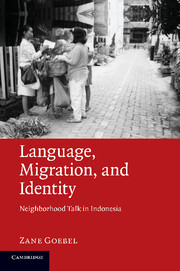Book contents
- Frontmatter
- Contents
- Figures
- Diagrams
- Maps
- Tables
- Extracts
- Preface
- Conventions
- 1 Introduction
- 2 Long-term Processes of Enregisterment
- 3 Enregistering Local Practices and Local Spaces
- 4 Linguistic Signs, Alternation, Crossing, and Adequation
- 5 Women, Narratives, Identity, and Expectations in Ward 8
- 6 Learning to Become a Good Ward Member
- 7 Emerging Identities in a Monthly Ward 8 Male Meeting
- 8 Chineseness as Deviance
- 9 Language Ideologies and Practice in Ward 5
- 10 Conclusions
- Notes
- References
- Index
1 - Introduction
Published online by Cambridge University Press: 04 August 2010
- Frontmatter
- Contents
- Figures
- Diagrams
- Maps
- Tables
- Extracts
- Preface
- Conventions
- 1 Introduction
- 2 Long-term Processes of Enregisterment
- 3 Enregistering Local Practices and Local Spaces
- 4 Linguistic Signs, Alternation, Crossing, and Adequation
- 5 Women, Narratives, Identity, and Expectations in Ward 8
- 6 Learning to Become a Good Ward Member
- 7 Emerging Identities in a Monthly Ward 8 Male Meeting
- 8 Chineseness as Deviance
- 9 Language Ideologies and Practice in Ward 5
- 10 Conclusions
- Notes
- References
- Index
Summary
Introduction
Indonesia is reported to be one of the most religiously, linguistically, and ethnically diverse regions of the world (e.g. Bertrand, 2003). Such diversity has attracted a lot of scholarly attention, especially from political scientists, historians, anthropologists and area specialists. For example, relationships between Javanese politicians from Jakarta and other Indonesian politicians from the outer islands has been an enduring topic of interest (e.g. Feith, 1962; Ricklefs, 1981; Sakai, 2002). Similarly, much scholarship has gone into relationships between bureaucrats from these geo-political spaces and discourses about those living in the outer islands (e.g. Hoshour, 1997; Lenhart, 1997; Schefold, 1998; Hoey, 2003), inter-ethnic and inter-religious relations (e.g. Bruner, E. M., 1974; Liddle, 1997; Hefner, 2001b; Sakai, 2002; Van Klinken, 2003; Bertrand, 2004), and social relations between Indonesian-Chinese and pribumi, or so called “indigenous Indonesians” (e.g. Coppel, 1983; Chua, 2004; Suryadinata, 2004b; Hoon, 2006; Purdey, 2006).
While many of these studies take into consideration post-structural arguments and social constructivist perspectives (e.g. Van Klinken, 2003; Purdey, 2006), their focus on interview, archival, and survey data usually doesn't allow us to explore how these social relationships form and dissolve though face-to-face talk. Indeed, with the exception of some very brief descriptions of actual inter-ethnic talk by Kartomihardjo (1981: 159, 186–7) and Wolff and Poedjosoedarmo (1982: 66–8), no work has been done on this aspect of diversity in Indonesia. This book attempts to start to fill this gap by investigating how talk figures in mediating social relations in two diverse urban Rukun Tetangga (RT) “ward(s)” of Semarang, Indonesia, referred to henceforth as Ward 8 and Ward 5.
Information
- Type
- Chapter
- Information
- Language, Migration, and IdentityNeighborhood Talk in Indonesia, pp. 1 - 11Publisher: Cambridge University PressPrint publication year: 2010
